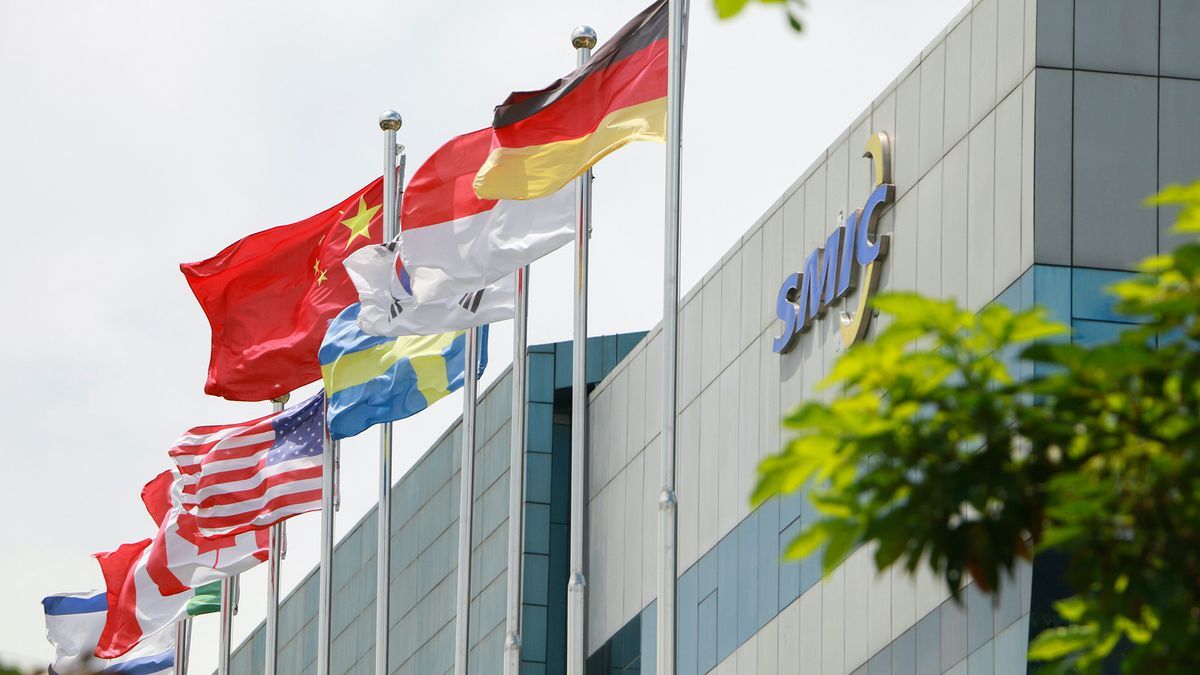Huawei and SMIC quietly rolled out a new Kirin 9000C processor.
Chinese foundry SMIC may have broken the 5nm process barrier, as evidenced by a new Huawei laptop listed with an advanced chip with 5nm manufacturing tech — a feat previously thought impossible due to U.S sanctions.
...Do you guys think this sudden Chinese ability to manufacture technology might have something to do with the entire Western World spending three or four decades outsourcing the manufacturing of every single kind of technology to China specifically because it was cheap? No, no, I realize that I sound crazy when I say that.
The countries being outsourced to aren't supposed to actually learn how to make the thing Brandon please you gotta stop this
The funniest part is that this is a trick that Lenin openly discussed in public speeches in the early years of the Soviet Union.
Probably the "the capitalists will sell us the rope we hang them with"
Lenin never said that it was said by some chud american politician
Apparently he actually said this:
‘They [capitalists] will furnish credits which will serve us for the support of the Communist Party in their countries and, by supplying us materials and technical equipment which we lack, will restore our military industry necessary for our future attacks against our suppliers. To put it in other words, they will work on the preparation of their own suicide’, in Novyi Zhurnal/New Review September 1961
The rope thing was probably a rough paraphrase
It sounds a lot like "uneven and combined development". Trotsky and Lenin were trying to figure out why if a technologically advanced nation moved all their high tech shit to an underdeveloped backwards country, why did the underdeveloped country remain backward? They realized that technology takes a long time to develop and where it develops and alienates the workers and causes all these social changes that workers organize against and the bourg has to make cultural adjustments...but once its finished you can just take it to a new country where it can be sold to the ruling class along with all the methods of suppression that were learned along the way, and the new tech just strengthens the ruling class in that underdeveloped country.
But it works the other way too. For example, after the failed 1905 Russian revolution, the burgeoning proletariat of Russia looked to workers organizations in more advanced countries and adapted the union form to suit their own purposes. But the Russian bourgeoisie was a joke and wasn't able to organize against the worker orgs, which became the soviets that grew into a dual power rival until they seized power in Feb 1917.
Uneven and combined development is definitely a crucial theory in order to understand historical development.
This probably
https://www.marxists.org/archive/lenin/works/1921/oct/17.htm
And the manufacturing can’t be brought back home, because the domestic costs of production have skyrocketed thanks to the financialization of everything in the interim period.
Also because manufacturing takes a lot of skill, and so much of it has been outsourced for so long that the Western world simply lacks the infrastructure to be able to do it. And infrastructure in this case doesn't just mean equipment. Equipment could be procured quickly. It a also means a population with the relevant education for and, above all, experience with working in large scale manufacturing of complicated products.
Once upon a time "Made in China" really did mean that something was of dubious quality. Back when they started putting all the manufacturing in China simply because it was cheap and China was still getting to grips with how to do this large scale manufacturing with no experience and a severe lack of people educated in how it worked. Two or three generations later and that is no longer the case. Unsurprisingly, people raised and educated from birth in the world's largest manufacturer of goods are kind of good at making stuff. But moving production back would mean more than just building factories and machines. It would mean accepting that two or so decades long period where you are just learning how to make stuff in the 21st century.
Exactly. Not only the infrastructure, but also the expertise for it. You can't build on the knowledge of hundreds of engineers with decades of expertise in a subject without having the facilities. Especially with the new crop of engineers, 70% of whom are coming out of school basically running everything through Chat GPT and not actually understanding how anything works, setting them years behind their international competition. It's not even their fault though, only the top 5% of engineering schools get any kind of real funding, everything else is expected to get additional funding through endowments, which means even STEM curriculum gets massively underfunded to what it would take to actually industrialize the nation intellectually, which is what we would need since we do not have the labor based to support that. There is literally only one school in the U.S. that does a masters or doctorate program in manufacturing engineering for welding. One. For the whole country. There are only a few schools in the U.S. that offer plastics engineering, or even generalized manufacturing engineering.
University of Ohio, pretty sure it is in Boise, but most of those professional graduates degrees are mostly online these days.
This stuff always reminds me of China's nuclear program in the 60s. Like once the Sino-Soviet Split happened the US literally just assumed that Chinese people were too stupid to produce an atomic bomb. Even after China's first nuclear test in '64 the US would not recognize them as a nuclear power, and kept insisting they would be unable to develop nuclear armed ballistic missiles or thermonuclear weapons, both of which were then tested in the next two years and both times it was deeply shocking to the US foreign policy blob.
Also, the US went on to learning nothing from this becuase the exact same thing happened with North Korea which went from their first nuclear test to thermonuclear weapons in 10 years. Like in the early stages North Korea was very willing to surrender their nuclear weapons program for lifting of sanctions, but the US would never negotiate in good faith becuase they genuinely believed the North Koreans were to primitive to proceed to the next stage of development.
"Nooooo you yellows can't just... Invent things. You're supposed to be good at rote math but not creative like ussssss!"
 how could you possibly create nuclear ICBMs without a profit incentive!!!
how could you possibly create nuclear ICBMs without a profit incentive!!!Turns out the thought of being able to reduce the KKKrakas to radioactive dust is a very powerful incentive for most people.
American racism will continue to be their biggest downfall
The followers must feel humiliated by the ostentatious wealth and force of their enemies..... However, the followers must be convinced that they can overwhelm the enemies. Thus, by a continuous shifting of rhetorical focus, the enemies are at the same time too strong and too weak. Fascist governments are condemned to lose wars because they are constitutionally incapable of objectively evaluating the force of the enemy
I just read an article about how the only reason they got to 7nm was because they were abusing their less advanced methods by being willing to make a ton of faulty chips for every good one, and that it was incredibly inefficient and only feasible because of STATE INTERVENTION which is a free-market cheat code. Basically the human-wave attack propaganda but for microprocessors, lol.
Seems like they figured some things out on their own.
They can’t imagine a mode of production centered on actually producing things instead of just making money.
I just read an article about how the only reason they got to 7nm was because they were abusing their less advanced methods by being willing to make a ton of faulty chips for every good one
So… research and development?
Complaining that chemists don't make a new chemical perfectly on the first try
You always have low yield when developing new processes. You can't make a 7nm process by just running 14nm at high throughput/low yield. This is just R&D and process development.
The fact they didn't do it perfectly and better on their first try is because their ideology told them not to.
lol. everyone knows that US processor production is lossy too. They just turn off the buggy sectors and sell it as an i5 instead of an i7 or whatever.
Exactly right; IIRC just how many of the produced chips are actually functional is systematically kept secret by manufacturers, too, but there are a lot of duds.
Basically the human-wave attack propaganda but for microprocessors, lol.
The one
with the rifleshoots. Theone withoutzero follows. When the onewith the rifleis killed, theone followingzeropicks up the rifle andshoots.STATE INTERVENTION ... is a free-market cheat code
They're speedrunning chip development by using exploits the capitalists didn't intend. Sure, this looks impressive, but I only respect glitchless runs
feat previously thought impossible
our geopolitical foes aren't inherently dumber than us :0
Its going to be fake and not real and also stolem because its china
Damn, you summerised every comment I've seen about it in 2 lines. You're talented.
It's also going to be bad and not work and also it's going to spy on you. Because China.
There were professional analysts who said this about the Kirin 9000c and then two weeks later had to eat crow as the chips became available and we're analyzed by third parties.
"defying U.S. sanctions" the most beautiful combination of three words you will ever hear
defying U.S. sanctions
because the US tried to stop a chinese company from doing business with anothe chinese company lol
Huawei: "I consent"
SMIC: "I consent"
CIA: "WAS THERE SOMEBODY YOU FORGOT TO ASK?"
“7 nm”, “5 nm”, etc are all lies at this point. They mean nothing, just marketing terms. Nothing actually measures 5 nm. Idk what they’re doing to make the processors better, but it’s not shrinking the transistors as the name implies.
And since it’s a marketing term, there’s no objective way to measure it.
The term "5 nm" has no relation to any actual physical feature (such as gate length, metal pitch or gate pitch) of the transistors being 5 nanometers in size. According to the projections contained in the 2021 update of the International Roadmap for Devices and Systems published by IEEE Standards Association Industry Connection, a "5 nm node is expected to have a contacted gate pitch of 51 nanometers and a tightest metal pitch of 30 nanometers". However, in real world commercial practice, "5 nm" is used primarily as a marketing term by individual microchip manufacturers to refer to a new, improved generation of silicon semiconductor chips in terms of increased transistor density (i.e. a higher degree of miniaturization), increased speed and reduced power consumption compared to the previous 7 nm process.
Apple markets their latest processors as “3 nm”.
I haven't really dived into the IEEE standards here, but this is a real thing and not purely marketing. It is the resolution of the lithography. Due to the higher clock speeds and current resolutions, the capacitance and inductance of the elements set the size of transistors and routing, rather than just how small you can pattern them. So it is not directly increasing transistor density and processing power, but it means that you are patterning elements more accurately to what you designed and have less variation element to element. Meaning that things can be optimized and more consistent.
Lithography resolution varies - EUV is 13.5nm light and DUV is 190 - but you can get smaller features than that.
there’s no objective way to measure it.
Except for TDP, synthetic performance benchmarks, Wattage, Treat Supply Augmentation, efficiency, supported processor extensions.
I admit the misfortune of most of this things being abstract and partially derived from the surrounding components, but we're also nearly into the territory that the last mile of improvements require the entire computer (e.g. RAM/wifi/GPU/disk) must all be embedded into the final chip.
We probably still have at least two big performance leaps left before we have to either abandon silicon based transistors or the FET based logic gate. The next big thing Intel, TSMC, Samsung, and IBM are all working on is replacing the FinFET transistor we currently use for logic with Gate All Around Field Effect Transistors (GaaFET). Everyone will stay on gate all around for maybe 5 to 7 years and after we have squeezed out all possible performance optimizations, most roadmaps point to something like non-planar designs with multiple logic gates vertically stacked atop each other (CFET) being the next evolution. After that, maybe FET based logic gates on silicon will have finally hit their limit and a new material like germanium will be adopted... or we might just replace FETs all together with new forms of logic gates based on a novel mechanism.
but we're also nearly into the territory that the last mile of improvements require the entire computer (e.g. RAM/wifi/GPU/disk) must all be embedded into the final chip.
We already went there, all modern CPUs (Intel, AMD, ARM) are true SOCs (systems on a chip) where the components that used to be discreet (south bridge, north bridge, memory controller, clock generators, io/storage/network/usb controllers) are now integrated on the same silicon as the CPU cores themselves. The latest generation chips from both Intel and AMD are even leveraging 3D integration (vertically stacking modules on top of each other) to squeeze out that last bit of extra performance while maintaining the same physical footprint. It's at the point where they are 3D stacking up to a gigabyte of SRAM based L3 cache directly on top of CPU cores or putting up to 128GB of HBM ram directly on the CPU package to act as an L4 cache.
Some people assume only CPUs built for mobile devices (phones, laptops) are full SOCs but desktop/server CPUs that get socketed into a motherboard at this point are also true SOCs. Modern desktop and server motherboards tend to be nothing more than power delivery components and a physical jig that makes it easy to plug peripherals into the CPU SOC or connect multiple CPU SOCs together on one board. Other than increasing the bandwidth of interconnects, there is still very real performance that can be gained by lowering the latency between CPUs and plug in peripherals like memory DIMMs, discrete GPUs, network adapters, or other CPUs via replacing electrical traces with photonics. Intel's lab division has been working on maturing silicon photonics to the point it can be directly integrated into a CPU.
that's interesting. I think it does still have to do with the amount of power being used for the chip? Like the Steam Deck LCD is 7nm i think and the new one i believe is 5nm, which doesnt make it faster it makes it more efficient and the battery lasts longer as a result.
Looks like they call it “6 nm” which is unusual. Yeah something is improved in the chip, but the marketing isn’t any kind of objective measure of that. Although I imagine most of the improved battery life comes from the bigger battery and more efficient OLED screen.
at the same voltage, smaller transistors don't necessarily lower power because it's easier for electrons to jump across the smaller gaps and leak power that way. but the smaller size usually enables reductions in voltage and shorter wires mean less losses to heat, which entails lower power draw.
Academics use smallest pitch distance to measure resolution. It is a real thing it's just not measuring the size of the transistors themselves (which would vary by design anyways and also that's not the only tuing you can microfabricate).
Apple markets their latest processors as “3 nm”.
Because they are 3nm. Produced by TSMC in Taiwan.
It's amazing how willing the US government is to do this, it would be very rough for the national governments if they just banned the import of these things in order to develop their own productive capacity. Xi and Putin should send Biden thank-you cards for helping them out so much.
It's really hilarious how much the old ghouls who were part of the creation of this new world order are aware that the absolute midwit shitbirds running the show today are tearing it down without meaning to. Mearsheimer is similar in being a real ghoul who can tell the dummies in charge now are doing imperialism wrong, and I get great enjoyment out of it.
Kinda want to get my hands on a Huawei Qingyun L540 laptop now, but they’re not available to backwater markets like Burgerland.
You can import them, but I don’t know if the US has banned carriers for working with Chinese phones. I know a lot of dumb phones don’t work in the US because they’re blocked
Turns out if you offer capitalists money for something they will take it
impossible due to U.S. sanctions
have they learnt nothing from the ukrainian war
You can already buy laptops & tablets that come w/ Linux pre-installed & have open-source firmware.
StarLabs and System76 being a couple I know off the top of my head
You can, but most of those aren't very good, are too niche, and borrowing CPUs designed around the whims of Microsoft has me doubting their nativeness.
You're going to be waiting quite a while for a "Linux native CPU", whatever you mean by this. RISC-V is still a long way out from being desktop ready, but progress is slowly happening.
borrowing CPUs designed around the whims of Microsoft has me doubting their nativeness
the major cpu vendors all work on the linux kernel because they need big server purchasers to buy new hardware. iirc, linux had support for intel's new efficiency core scheme before windows did for this reason - kernel standards are fairly high and it can take awhile for new features to actually land.
I think what you're actually thinking of is Intel's management engine, which is a server feature they forced into every processor - presumably to encourage businesses to buy Intel (look ma, remote management) but that looks a hell of a lot like NSA spyware. AMD doesn't include their equivalent on consumer-grade hardware and their implementation doesn't allow for anywhere near the same kind of spying. obviously, open hardware would set all doubts to rest.
And it's not impossible to get rid of Intel's management engine, you just have to be comfortable enough with flashing some chips on your motherboard. There are even some manufacturers who do this for you, but you just have to kind of take their word for it.
flashing some chips on your motherboard
Can you share links to any resources regarding this?
It varies for every bit of hardware so you will have to do a bit of research, but this should put you on the right track




























